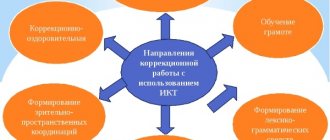A pictogram (from Latin pictus - “drawn” and Greek gramma - “record”, “written sign”) is a drawing-symbol. It depicts some event, object or action .
Pictographs were used even before the advent of writing, for example, in Ancient China and Ancient Egypt.
Nowadays, pictograms are used as signs that facilitate the transfer of information .
For example, as signs on the road or a schematic representation of some other rule, at airports, train stations, in the subway, to indicate functions in computers, etc.
Defining emotions for children
For speech therapy work with students in the senior and preparatory groups of kindergarten, use the following list of emotional states:
Joy is a positive emotion familiar to everyone. We feel joy when something good happens. A person can express this feeling through words and actions. Signs of a joyful state are laughter and smiling. Experiencing joy feels good, as does bringing it to others.
Sadness is a feeling that appears when we learn or think about something sad. Sadness cannot be called a strong emotion; it passes quickly. This does not mean that you should not allow yourself to be sad; sometimes every person needs it. But you shouldn’t indulge too much in a sad mood; it’s more useful to try to quickly get rid of it by doing something pleasant or useful.
Anger is anger, strong irritation towards someone or something. Feeling angry is not pleasant, but sometimes it happens to everyone. It is a strong emotion that can cause trouble for us and others. It is important to explain to children how to manage anger and be able to express it correctly. If a person is often angry, then it is difficult for him to find friends, he is often lonely.
Fear is a strong negative emotion that people experience if they are threatened by something. The danger can be real or expected or imaginary. Every child has repeatedly felt fear, so he can easily recognize its image in illustrations or photographs, and also give examples of events, objects and phenomena that cause this feeling in them. Children should know that fear varies in intensity, from fear to horror. It is important to explain to children that this emotion is necessary for a person, as it warns of danger. It can be added that the color black is often used to illustrate fear in pictures.
Admiration is a pleasant emotion that arises when encountering something very beautiful or unusual. Admiration can be caused by: an unusual toy, a garden in bloom, an elegant girl. People, expressing admiration, use special exclamations: (oh, ah, wow, wow) and words (really, amazing, wonderful, wonderful, extraordinary). Admiration can be so strong that it is very difficult to express your feeling in words. From a photograph or drawing, preschool children can easily recognize a person who admires something, although it is difficult for them to describe his feelings; this requires special speech therapy training.
Shame is an unpleasant feeling that occurs when we have done something bad and regret it. The older the children, the easier it is to explain to them the essence and meaning of this emotional state. Signs of shame are not only certain facial expressions, but also redness of certain parts of the face (cheeks, ears, neck). Knowing this feature will help preschoolers quickly and easily recognize shame in drawings (by the way, this sign can often be seen in story pictures for children and even in selfies) and in the behavior of people around them. You can have a conversation with children 6-7 years old about the difference between shame and shyness; these states are easy to confuse.
Resentment - a person feels resentment when someone’s action seems unfair to him. Some people are touchy, others rarely experience this emotion. It is difficult to describe the state of resentment; preschool children should be able to recognize its image. To do this, you can use both schematic images (for example, emoticons - simple pictures of emotions for children), and realistic drawings, color or black and white photographs. By the way, it is convenient to print such visual material from collections and presentations on specialized speech therapy websites.
From Sumerians to Emojis: How Pictograms Help People Communicate
Messengers are consistently among the top ten most popular applications by number of downloads. Most of them support not only text messages, but also video and voice calls. People willingly use these functions when they need to save money on international negotiations or communicate with loved ones, but the vast majority of our communications take place the “old fashioned way” - in writing.
This is where the problem arises. The text “eats” important signals for human communication, such as facial expression, tone of voice, and gestures. We no longer write lengthy letters with verbose thanks or elaborate insults. This may seem unimportant, but remember the discussions about what the period at the end of a message in the messenger means.
An innocent punctuation mark designed to separate sentences is perceived as rude and aggressive in everyday online communication.
Emoticons and emojis come to the rescue - stylized drawings depicting human emotions, animals or objects. They clarify, reinforce, and even replace our words, and besides, they are understandable to everyone, regardless of age or knowledge of foreign languages. These pictograms have become the standard of digital communication and, one might say, the alphabet of international communication.
New savages
It would seem that pictures for communication are a return to the archaic. Throughout the world, the development of written language followed the same pattern: from drawings to pictograms (simplified, schematic images), from pictograms to ideograms (symbols denoting concepts or ideas), then to hieroglyphs and phonetic writing (alphabet).
Sumerian writing, known examples of which date back to the 4th–3rd millennia BC, is precisely an example of such evolution. The drawings on clay tablets depicting people, mountains, cows, and birds became more and more schematic and conventional over time in order to simplify recording. The simpler the graphic signs, the more complex the writing system and the more diverse the meanings that can be conveyed with its help. For example, combining the pictograms “mouth” and “water” gave the meaning “to drink,” and the pictogram “star” began to mean the sky or god.
It’s quite a convenient system, considering that to read such a record you don’t need to specifically learn to read and write. But even by combining drawings and creating new symbols (the number of which is inevitably limited), only practical information can be conveyed. The Sumerian tablets were mainly bills, promissory notes, and business correspondence.
A pictogram means an object or action, but does not have an exact phonetic analogue; it cannot be read out loud - it can only be understood.
The writer and the recipient can speak different languages, but understand each other using pictograms. It is true that when it comes to abstract ideas, image interpretation is an unreliable method of translation. It is impossible to record with drawings a literary work or a story of heroic conquest.
The development of writing led to the emergence of phonetic graphic systems, where signs correspond to the speech sounds of a particular language. In particular, Sumerian writing in Mesopotamia evolved into cuneiform, which made it possible to record the Epic of Gilgamesh. True, these writings were not intended for the eyes and understanding of the general public, and it took several decades to decipher them in the 19th century.
Pictographic and ideographic writing existed in Ancient Egypt and Ancient China until it was transformed into complex hieroglyphic systems in the Aztec civilization. Picture writing was preserved among some tribes of American Indians and indigenous peoples of the North until the 20th century, until missionaries and officials finally “civilized” them.
In a broad sense, rock paintings and petroglyphs can be considered pictograms. Their authors hardly intended to convey information to other people in this way - scattered communities of hunters and gatherers hardly saw the point in this. However, modern researchers can get an idea of the ancient fauna, hunting methods, and beliefs with the help of drawings on stone.
Utopia for the illiterate
The signs of phonetic writing cannot be understood intuitively, like pictograms; they are different in each language, which means that in order to find out the meaning of the message, you need to speak the language and be able to read it. For thousands of years, literacy was the preserve of the highest strata of society: the aristocracy, the clergy, as well as officials and merchants.
The “Dark” Middle Ages gave rise to the phenomenon of street signs. Any city dweller who could not read could tell where a shoemaker's workshop or a wine shop was located: near the first there was a boot hanging, near the second - a barrel. Universal symbols appeared, for example, a key for locksmiths, three balls for money lenders. Very similar to modern signs!
Jonathan Swift, in Gulliver's Travels, describes a radical project for a language that everyone could understand, based not even on drawings, but on real objects.
Thus, the residents of the country of Laputa suggested saving energy and communicating with foreigners: “The author of the project suggests that it will be much more convenient for us to carry with us the things necessary to express our thoughts and desires. <…> Its only inconvenience is the fact that, if it is necessary to conduct a lengthy conversation on various topics, the interlocutors have to carry large bundles of things on their shoulders. <…> The great advantage of this invention is that it can be used as a universal language, understandable to all civilized nations.”
Perhaps this episode is an ironic reference to the idea of creating a universal language that captured the best minds of the Enlightenment. Descartes in 1629 outlined the foundations of “philosophical language,” which, in his opinion, should be more suitable for obtaining knowledge than natural language, which is full of logical errors and inaccuracies. Leibniz was engaged in the development of pasigraphy - a universal writing system “for all peoples on earth, no matter what different languages they speak.” In the 19th century, perhaps the most famous artificial languages appeared, designed to unite humanity: Volapuk by Johann Schleyer and Esperanto by Ludwik Zamenhof.
All artificial language projects for international communication, successful and not, have one significant drawback: this language must be learned in the same way as any other foreign language, that is, master the grammar and remember thousands of words. And now we return to pictograms.
The Age of Pictures
In the 20th century, the spread of literacy, the rise of mass media and advertising, and the emergence of new mediums made it possible to simultaneously deliver the same information to millions of people. At the same time, a significant part of humanity found itself in an alien linguistic environment as a result of wars and revolutions. And in the second half of the century, a tourism boom, mass sports and cultural events completed the formation of the international world.
It has become clear that writing is certainly a useful invention, but when it comes to conveying information quickly, attracting attention, or appealing to the basic senses, nothing beats pictures.
The embodiment of this idea are pictograms, which are already so familiar to us that we read their meaning automatically. They have turned into a truly international language, although it cannot be called a full-fledged means of communication - only an auxiliary tool. Examples include signs, traffic signs, and operating system icons. For example, a red cross means a hospital, a walking person in a red triangle means “crossing is prohibited,” silhouettes of a man and a woman mean a toilet, a floppy disk icon means “save,” a gear means settings. Yes, the last two objects, for example, have not been seen by all living smartphone users, but they are able to recognize the corresponding icons and understand what these images mean.
Entire writing systems based on pictograms are also being created. At the beginning of the 20th century, the Estonian scientist Jakob Linzbach came up with the so-called transcendental algebra. Dutch journalist Karel Janson and German professor Andre Eckart created the picto system in 1956.
Smiling face
The inhabitants of Swift's Laputa, as you remember, were forced to carry a bunch of objects with them in order to communicate with each other. We have smartphones, and on their screens we can show any thing. Why not take advantage of this opportunity? However, the depiction of objects is the oldest stage in the development of writing, which humanity has long passed. In the digital age, conveying emotions has become more relevant.
“I often think that there should be a special typographic sign that means a smile,” Vladimir Nabokov once said.
Even he took into account the partial loss of meaning in written text compared to live speech. Emoticons are designed to compensate for this shortcoming - pictograms made up of typographic characters and conveying emotions. The emoticon was first used by Carnegie Mellon University professor Scott Fahlman in 1982. He suggested using symbols in email messages





